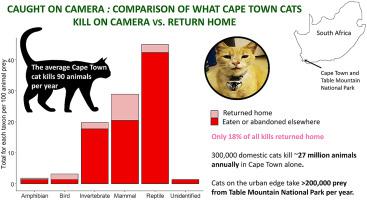Global Ecology and Conservation ( IF 3.5 ) Pub Date : 2020-07-20 , DOI: 10.1016/j.gecco.2020.e01198
Colleen L. Seymour , Robert E. Simmons , Frances Morling , Sharon T. George , Koebraa Peters , M. Justin O’Riain

|
Domestic cats (Felis catus) have contributed to the extinction of indigenous species worldwide, but impacts in Africa are unstudied. We compare prey returned home from three questionnaire surveys (2009, 2010 and 2013/14) in Cape Town, South Africa, with footage from some of the same cats wearing animal-borne video cameras (KittyCams), to assess differences in actual predation vs. returns. Cape Town borders Table Mountain National Park (TMNP), so cats may prey on animals in a protected area. Urban edge (UE) and deep urban cats (DU) did not differ in predation rates, but the suite of species differed significantly. KittyCams revealed that most predation was nocturnal, and only 18% of prey recorded on video were returned home, thus, cats kill 5.56 times more animals (averaged across all taxa) than returns data suggest. Reptiles constituted 50% of prey, but only 17% of returns; mammals constituted 24% of prey, but 54% of returns. Non-native species represented only 6% and 17% of animals killed by UE and DU cats, respectively, pointing to a high cost of cat predation for native fauna. Applying a correction factor of 5.56, the average domestic cat in Cape Town kills c. 90 (95% CI = 59, 123), animals.year-1. Thus, the approximately 300 000 domestic cats in Cape Town kill c. 27.5 million animals.year-1, and TMNP is likely to lose c. 203 500 animals to UE cats annually from within its boundaries. The scale of this predation necessitates conservation options to minimise impacts of cats on wildlife, particularly near protected areas.
中文翻译:

陷入相机:城市家猫对非洲城市及邻近保护区中野生猎物的影响
家猫(Felis catus)已为全球土著物种的灭绝做出了贡献,但对非洲的影响尚未研究。我们将南非开普敦的三份问卷调查(2009年,2010年和2013/14年)返回家中的猎物与一些戴着动物摄像机(KittyCams)的相同猫的镜头进行了比较,以评估实际捕食与返回。开普敦与桌山国家公园(TMNP)接壤,因此猫可能会在保护区内捕食动物。城市边缘(UE)和城市深猫(DU)的捕食率没有差异,但物种的集合差异很大。KittyCams透露,大多数捕食活动都是夜间活动,录像中记录的猎物只有18%被送回家中,因此,猫杀死的动物(在所有分类群中平均)比返回数据暗示的多5.56倍。爬行动物占猎物的50%,但只占回报的17%。哺乳动物占猎物的24%,但占回报的54%。非本地物种分别仅占被UE和DU猫杀死的动物的6%和17%,这表明本地动物对猫的捕食成本很高。应用校正系数5.56,开普敦的家猫平均死亡率c。90(95%CI = 59,123),animals.year -1。因此,开普敦大约30万只家猫杀死了c。在- 1年内,有2750万只动物,而TMNP可能会损失c。每年有203 500只动物从其边界内转移至UE猫。这种捕食的规模需要采取保护措施,以尽量减少猫对野生动植物的影响,特别是在保护区附近。


































 京公网安备 11010802027423号
京公网安备 11010802027423号